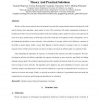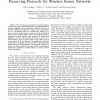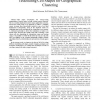322 search results - page 35 / 65 » Percentage Coverage Configuration in Wireless Sensor Network... |
IJSNET
2008
13 years 7 months ago
2008
Abstract: This paper addresses the target coverage problem in wireless sensor networks. Communication and sensing consume energy, therefore efficient power management can extend ne...
IJSNET
2006
13 years 7 months ago
2006
: In this paper, we present a two-tiered scheduling approach for effective energy conservation in wireless sensor networks. The effectiveness of this mechanism relies on dynamicall...
WINET
2002
13 years 7 months ago
2002
Wireless ad-hoc sensor networks have the potential to provide the missing interface between the physical world and the Internet, thus impacting a large number of users. This conne...
ISCAS
2005
IEEE
14 years 1 months ago
2005
IEEE
Abstract— The wireless sensor network is an emerging technology that may greatly facilitate human life by providing ubiquitous sensing, computing, and communication capability. H...
IEEECIT
2010
IEEE
13 years 6 months ago
2010
IEEE
This paper investigates the energy-saving organization of sensor nodes in large wireless sensor networks. Due to a random deployment used in many application scenarios, much more n...



